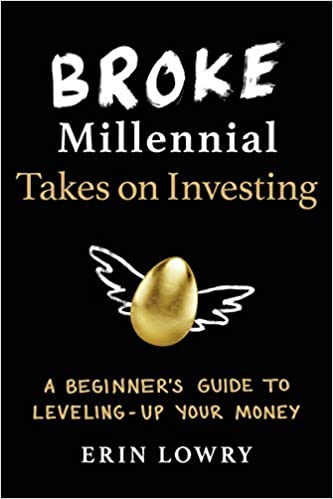Broke Millennial Takes On Investing — Book Summary
Introduction
Broke Millennial Takes on Investing: A Beginner's Guide to Leveling Up Your Money by Erin Lowry is, as the book title suggests, a guide for millennials who want to know how to invest their money but have no idea how to do so.
Lowry goes beyond the concepts of business investment and delves into other topics such as the anxieties or potential concerns readers may have when considering the path of financial investments and buying and selling stock. She also tackles questions that students who are considering either paying off their student loans or investing their money might have.
Lowry demonstrates how the mindset of the wealthy can be achieved even while being a broke millennial.
An interesting quote from the book
Investments are the sexiest part of personal finance, but it’s just one piece.
— Erin Lowry, Broke Millennial Takes On Investing
Summary of the book Broke Millennial Takes On Investing
Preface: Is This Book Right for You?
Lowry admits that it was not easy for her to break into the market. She acknowledges that the investment jargon in most investment self-help books is difficult to follow. For that reason, she wrote this book in a tone that she believed would be relatable to her readers—a younger audience that is not involved in the investment market.
Introduction: The Case for Investing
During her senior year of college, Lowry had a conversation with her father about investment or saving. She was under the impression that investing was for older people who were saving for a retirement fund. Her father, however, informed her that this was not the case; anyone who wished to avoid financial insecurity should consider investing.
Lowry breaks down why someone would need to invest their money:
- Compound interest
- Inflation
- Time
Chapter 1
Lowry begins the first chapter of the book by discussing the initial steps she took toward investing.
She reiterates that investing is not just for wealthy people nor is it just for older people – it is for anyone interested in making the most of their money.
Lowry then provides an investing checklist:
- Set financial goals.
- Master cash flow.
- Set aside cash reserves for your emergency fund and short-term goals.
- Pay off consumer debt.
- Ensure student loans are current (if they have not been paid off).
- Educate yourself on the stock market.
- Start saving for retirement.
Lowry informs her readers that they should make a checklist of reasons why they may not be ready to start investing:
- You have not set financial goals.
- You still have credit card debt.
- You do not have emergency savings.
- You have not taken the time to learn about how the stock market works.
- You have not started contributing to an employer-matched retirement plan (if it is available).
Chapter 2
The bulk of this chapter deals with terms that an investor should know before getting into investment.
The chapter also touches briefly on retirement terms and investment theories.
Chapter 3
Lowry acknowledges that risk-averse readers may find themselves fighting the urge to remove their money from the stock market.
She informs her audience that they should expect their investment to go down at some point but not to worry about it prematurely.
She also reminds her audiences to remember not to check their investments too often.
The checklist she suggests to her audience to handle risk includes the following:
- Embrace the fact that the market will go up and down.
- Put an investing plan in place that will align with your risk tolerance but will also help you meet your goals.
- Understand the importance of asset allocation and diversification.
- Set up barriers to protect you from yourself when the market drops.
Chapter 4
In this chapter Lowry elaborates on the steps of a first retirement plan that a beginner investor should consider:
- Step One: Decide how much you want to save.
- Step Two: Decide what types of investments you want.
- Step Three: Consider the costs of the funds.
This chapter also elaborates on the different retirement terms. Lowry emphasizes the reason an investor should invest in their goals.
The checklist a beginner investor should have when they are ready to invest outside of their retirement accounts is as follows:
- You do not have any high-interest rate debt.
- You have funded your emergency savings with a minimum of three months' worth of living expenses.
- You are maxing out your 401(K) or other retirement and health savings.
Chapter 5
The checklist for investing while you have yet to pay off a student loan is:
- Crunch the numbers on your interest rates; prioritize paying off debt over investments outside retirement accounts if the student loan's interest rate is over 5 percent.
- Consider the employer match.
- Know your risk tolerance.
- Embrace your emotional relationship to debt.
Chapter 6
DO NOT FORGET TO:
- Set your goal (remember why you are investing).
- Determine your risk tolerance.
- Decide how you want to use your money.
- Collect all your personal information.
- Decide the type of account you wish to open—retirement, saving for education costs, or general savings.
- Compare fees.
- Pick a brokerage firm.
- Pick a type of investment.
Chapter 7
When buying individual stocks:
- Remember that picking an individual stock to buy does not prevent you from losing money. You should still be emotionally and financially prepared to lose money.
- Do your research and thoroughly vet the company before making the purchase.
- Pick a brokerage firm but remember to compare different commissions and trading fees.
- Decide how you are going to invest and how you are going to place the order.
- Determine ahead of time if this is a buy-and-hold purchase and remind yourself of your goal to emotionally handle volatility.
Chapter 8
When micro-investing:
- Research the different app options and decide which one is the right fit for both your style and your current investing needs.
- Take advantage of all the education platforms and tools available to you within the app.
- Do the math on costs.
- Do not just rely on the gimmicks of apps. Set up recurring deposits.
- Password-protect your account on any app.
Chapter 9
Which is better, a robot advisor or a human advisor? When you are ready to invest you will be able to determine which option is better suited to your needs. Ensure your financial situation is not too complicated and you are in a position where you are open to getting help before deciding. After you have determined whether you require help, determine your comfort level with an AI versus a real person and vice versa.
Chapter 10
Understand that your standards and the brokerage's standards may be different, but make sure you still do your research and avoid relying exclusively on impact investment.
Chapter 11
If the market is going to go down remember the following:
- Stay calm.
- Ensure you have an investing strategy in place.
- Take some time off—do not make any rash decisions.
- If it is imperative to make a decision, make it after speaking to a financial advisor.
- AVOID CHECKING YOUR INVESTMENTS AFTER THE MARKET CRASH.
Chapter 12
The checklist to bear in mind here includes the following:
- Ask questions.
- Are you emotionally and financially prepared to potentially lose a certain sum of money?
- Did the potential investment sound like a sales pitch or does it fit your personal goals?
- Did you vet the broker/financial advisor/investment advisor?
- Do not be afraid to listen to your gut feeling.
Chapter 13
Be strategic, do not rush into selling investments.
Chapter 14
The checklist for this chapter is as follows:
- Wealthier people build companies/businesses with longevity in mind.
- They have a mindset of improving their finances. As a result, they save early and consistently and are strategic about their career moves.
- They consider how to minimize the impact of taxes on their income and investments.
Conclusion: Now It's Time to Level Up!
Key Lessons from the book
Lesson 1: Keep your investments separate from your regular banking accounts.
Lowry consistently elaborates on rebalancing and knowing when to check—and when not to check—investments.
It is important to remember that rebalancing investments helps the investor to stabilize their risk level by reallocating their investments to their original risk level as opposed to higher risk levels. Lowry reminds her readers that they should remember to keep their investments separate from their regular banking accounts. This is to ensure that the investor avoids the anxiety that comes with checking their account frequently versus every six months to a year, as Lowry suggests.
Lesson 2: Determine the purpose of your investment.
Another key question Lowry raises in her book is whether all investments should be intended for retirement. According to Lowry, the investor must determine the purpose of their investment, whether the goal is for short-term or long-term gain.
Lowry maintains that the younger generation should not feel pressure to invest long term if it will cause them problems in the present day, for example, if they require present-day access to those funds.
This is the same mentality young people should have when considering paying off their student loans or any debts they may owe. Lowry's advice is for the reader to pay higher loans off before deciding to invest, as investing may prove to be a costly, stressful situation.
Lesson 3: Buy-and-hold mentality can be good for your financial growth
When looking to invest, the buy-and-hold mentality, although not mentioned extensively, is a helpful concept to know.
As Lowry states, the strategy is solid because the investor must remember not to panic and sell when the market drops. Instead, they should brace themselves for long term ups and downs. Lowry explains how the buy-and-hold mentality can positively impact an investor's financial growth and wealth over time.
This is helpful advice for first-time investors who may not know how to react when they experience their first market drop.
Review of the book Broke Millennial Takes On Investing
In my opinion, Erin Lowry's youthful, conversational tone makes the content of this book easy to digest. As a non-business specialist, I would lose focus on the contents of the book if it were mostly technical. Instead, Lowry takes on a 'millennial' tone and even makes relatable references to this generation within the content of the book.
Lowry does a good job of breaking down large concepts into small steps, making it an ideal book for a beginner looking to get into investment.
Conclusion
Although Broke Millennial Takes on Investing mentions that the book is targeting "Broke Millennial(s)", it is not only helpful for broke millennials, but for any individual interested in investing their money.
The casual tone of the book is engaging as it simplifies an otherwise difficult topic. Non-specialists can comprehend financial investment without having to understand the particulars involved.
In conclusion, you do not need to be an expert to enjoy this book. I would recommend it to anyone but especially to younger people who are seeking to gain a better knowledge of investments.
Don't miss the other book summaries on SunInMe.org

